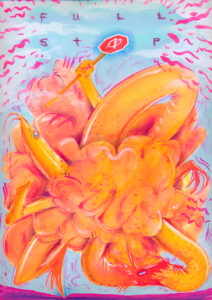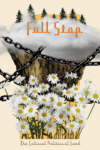The following is the introduction to the latest issue of the Full Stop Quarterly. You can purchase the issue here or subscribe at our Patreon page.

Is time itself a monster? In the broadest sense, time is what keeps us up at night, in that we do not know now what we will later know, and know with great clarity. Poised between extremes, the uncertainty is intolerable and so the present is intolerable. Time has become intolerable. The search for a vaccine was accelerated, but its potential impact remains unknown. All along, the virus’s protracted incubation period has complicated detection and management, any body at any time a potential carrier, any malaise potential onset. Justice moves too slowly—on a meaningful human-scale, it never arrives at all. Nearly half a year passed between the killing of Daniel Prude in Rochester and the release of incriminating police body cam footage. The election came and went, but not fast enough. So much still hangs in the balance. A peaceful transfer of power, faith in science, massive rates of unemployment, one-eighth of the planet’s species at risk of extinction, the window for meaningful action fast closing. The sleepless summer saw Death Valley hit 130 degrees, potentially the hottest temperature ever recorded anywhere on Earth. In the West, the wildfires continued to blaze into the fall, while the National Hurricane Center ran the alphabet naming this season’s procession of storms. The reopening of schools was predictably catastrophic. Infection rates are unimaginably high, and just keep rising. The stock market is wildly detached from reality. Protests against police brutality are re-ignited week to week by yet more police violence, and fatal altercations between protesters and counter-protesters. The fancy restaurants in midtown try to keep doing what they do—a matter of survival, can you imagine the rent?—their diners dressed to the nines and eating, we don’t know what, filet mignon, inside ugly makeshift bullpens inches from heavy-trafficked bike lanes and heaps of reeking garbage and protesters yelling “how can you eat?” over their plates. Stockpiles of PPE sit in unopened boxes in vacant office buildings. We are in a global pandemic that rides the circuits of global capitalism, and we can’t seem to find any means, to mix a metaphor, to jump the tracks and safely off-ramp towards a less dangerous destination.
In this era of profound political and labor disempowerment, we can barely remember the past or imagine a future. Marxist theorist Antonio Gramsci referred to moments like this one as “the crisis,” which “consists precisely in the fact that the old is dying and the new cannot be born; in this interregnum a great variety of morbid symptoms appear.” Or, as Slavoj Žižek has it in his creative mistranslation of the same quote, “Now is the time of monsters.” Although the two translations at first seem quite distinct, our conversation with anthropologist Andrea Muehlebach in this issue is a reminder that the monster has always been thought of as an omen or a sign. As Muehlebach tells us, “You have to look beyond the monster itself in order to understand what it actually means.”
In this issue we look at and beyond all sorts of crisis-bred monsters. These pieces assemble novel histories of transitional periods, both past and present, when unique circumstances converged to create “monstrous” conditions—widespread anxiety, paranoia, and the destabilization of political, social, and economic infrastructure. In some, readings of marginalized literary voices and forgotten cultural works generate alternative frameworks—whether philosophical, cultural, aesthetic, or political—to understand and incorporate these anomalous discontinuities of time within coherent, usable narratives. In others, such bridging narratives are rejected as impossible and even undesirable.
In the first section, “Timeout,” sports, and games more broadly, become the sites through which people can vicariously imagine a new political force emerging. Hannah Bornstein returns us to the oil shock of 1975, wherein sport and science fiction became the ideal conjunction to imagine the next phase of late capitalism’s interminable crisis. And in a very different game with time, Mark Clemens argues Homer’s Penelope offers a public account of waiting, that state which “dilates the present so neither the future nor, strangely, the past are conceivable.”
From this pause, we move to examine historical “Interregna.” Josh Allan writes of Brutalist architecture as an artistic movement not expressive of a transitional moment so much as an exception and anomaly. In their essay on the Partition of India of 1947, Lakshmi Mitra and Sudeshna Nag consider how the moment of crisis can render us vulnerable to dehumanizing tendencies and acute mental distress, leading literature to fill the interregnum with monstrous figures. And Dennis Hogan’s study of the cholera epidemic in colonial Panama shows that, sometimes, the monstrousness of the interregnum is simply the tenacity of entrenched inequalities under crisis conditions.
“Broodings” offers a series of philosophical reflections, from monstrous times—for example, in Kelly Swope’s unfolding of the myth of Hercules and the Hydra through slave revolts against transatlantic capitalism, the revolutionary and counterrevolutionary push and pull of the eighteenth century, and the promise of present-day pandemic labor activism. But attempts at synthesis give way in this issue—as they so often do—to “Paranoia.” No longer can paranoia be considered an affliction of the far-right, extreme, or fringe; as Joe George writes in his discussion of Gloria Naylor’s forgotten novel 1996, it seems we have all gone“bonkers.” And yet, George offers another face of paranoia: an inclusive vision of resistance and community in a time of oppression and isolation. Lorissa Rinehart opens up this oscillation between community building and alienation by looking at the development of UFO culture against the background of Cold War pride, and its subsequent devolution into the far-right movements of the 1980s and 1990s.
Paranoia can be relieved by accepting one’s lack of control and the inevitability of failure, and this is where our story ends. “Failure,” despite our attempts to confront it and subvert it, seems inevitable, as Drew Dickerson finds in William Gaddis’s lifelong obsession with the player piano. What, then, would it mean to accept failure? As Julie Reshe proposes in her rumination on the failure of philosophy, perhaps we need to settle in failure, lack of knowledge, lack of synthesis, and the explanatory lacuna which many feel so acutely during the current pandemic.
We may like to think of history as a line or as a circle, in either case, a continuity. But as in the interregna that preceded our present one, there is something complicated and obscure that is disrupting our experience of time and history—or revealing just how disjointed are time and history, really. And these writers contend with this “out of joint”-ness, in Shakespeare’s terms, that hangs behind any desperate attempt to stitch up events in a coherent narrative.
This post may contain affiliate links.







